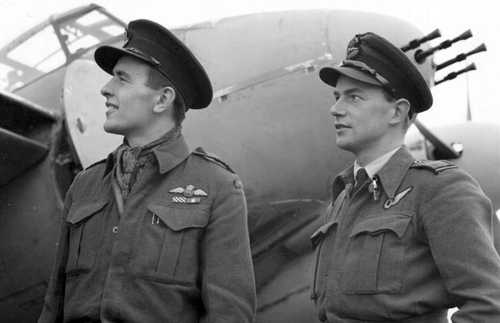
V1 Rocket Killer Dies
It was an enduring friendship forged in fiery skies above the English Channel nearly 70 years ago, a Canadian pilot and Scottish navigator renowned for their breathtaking seek-and-destroy pursuits of German V-1 pulse jets bound for targets in London and elsewhere in southeast England. Edmonton-born Russ Bannock, one of Canada’s most decorated Second World War airmen, is now 92 and retired in Toronto. And today he’s mourning the death of his wartime flying partner and lifelong friend, Robert Bruce, who passed away last month at age 96. Together, they earned a sterling reputation for defending Britain from both enemy aircraft and the pernicious V-1s, a remarkable 19 of which the duo reeled in and shot down as they sped toward the English coast, trailing flame, at more than 600 kilometres per hour. “Germany had launching pads all over the coast of France,” Bannock recalled Friday. “They’d fire these rockets off and they came across the channel at about 400 miles an hour. You could see them launch with a big flash, and they trailed a flame of about 20 feet. To catch them, we’d have to dive full-speed from 10,000 feet.” By July 1944, with the invasion of Normandy launched and German forces desperate to stem the Allied tide, the Nazis began firing thousands of the V1 “flying bombs” — forerunners of the Cold War’s cruise missiles — at the British capital and its surrounds. Known by various nicknames, including “buzz bombs” and “doodlebugs,” the V-1s were shaped like small aircraft and emitted a distinctive, high-pitched noise. About 2,500 of the bombs reached targets in London. The V-1s were blamed for killing more than 6,000 people in Britain and injuring another 17,000 between July 1944 and early 1945, by which time Allied gains on the battlefields of Western Europe had forced German forces to retreat too far eastward for the rockets to be effectively launched at Britain. But at the height of the V-1 attacks in 1944, Bannock and Bruce and the rest of the Royal Canadian Air Force’s 418 Squadron proved particularly effective at downing the deadly bombs before they reached England’s shore. “We were doing this at night,” Bannock told Postmedia News, describing Bruce as “an outstanding navigator” who expertly plotted courses through hundreds of kilometres of total darkness. “He had to get me to our destination, through all kinds of weather, and then back to base.” While flying together in Bannock’s de Havilland Mosquito fighter-bomber, the two were credited with destroying nine enemy aircraft. But they were best known for their effectiveness in destroying V-1s, which required a lightning-fast response once one of the airmen spotted the flash of a launch along the coast of occupied Europe. “We’d dive down on it and try to shoot it down,” Bannock said, recalling the chase. “I think our best was one night when we shot down four.” Bannock became known as the “Saviour of London,” according to his citation with Canada’s Aviation Hall of Fame, and was awarded the Distinguished Flying Cross and Distinguished Service Order for his illustrious service in the war. He’d spent the early years of the war as a flight instructor in Canada. Bruce had been sent to the Commonwealth airfield at Greenwood, N.S., for navigational training. The two hit it off and were soon “crewed up” for overseas deployment in 1944, Bannock remembered. “He was a very bright guy,” said Bannock, noting Bruce’s great gift for music — a passion that would lead the Scotsman to a postwar career as a music professor at Cardiff University in Wales. Bruce, who also earned a DFC for his exploits in the war, had been living in Hardwicke, England, since retiring from his university career. He and Bannock — who went on to a career as a de Havilland Aircraft test pilot and top aerospace industry executive — sustained their friendship through the decades, meeting at squadron reunions on both sides of the Atlantic and writing to each other in between. “We always kept in touch,” said Bannock, pointing out that two airmen “sitting side-by-side for four or five hours every night” — in a cramped cockpit, in a life-and-death struggle for freedom — naturally become “pretty close.” He knew his friend was ailing in recent months. “I had a letter from him two or three weeks before he died.” At his memorial service last week in Britain, Bruce’s wartime achievements were celebrated with a flypast by the Royal Air Force’s Hawk Singleton Squadron. “When I heard of the flyby from the Hawks I was very humbled,” his daughter, Katharine, told a newspaper in Gloucestershire. “To think they would do something so special for my dad is very moving. They have said there are so few aircrew left from the Second World War, and they were very keen to show their respect for him.”
This is a companion discussion topic for the original entry at https://ww2incolor.com/gallery/canadian-forces/47161/v1-rocket-killer-dies
